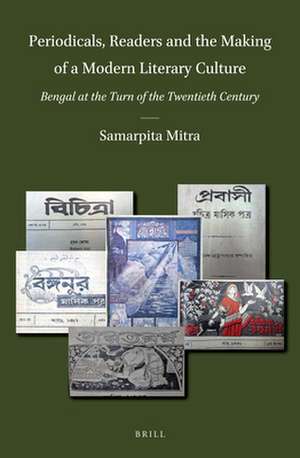Periodicals, Readers and the Making of a Modern Literary Culture: Bengal at the Turn of the Twentieth Century: Brill's Indological Library, cartea 52
Autor Samarpita Mitraen Limba Engleză Hardback – iul 2020
Din seria Brill's Indological Library
- 18%
 Preț: 1014.24 lei
Preț: 1014.24 lei - 18%
 Preț: 1137.16 lei
Preț: 1137.16 lei - 18%
 Preț: 919.14 lei
Preț: 919.14 lei - 18%
 Preț: 1139.18 lei
Preț: 1139.18 lei - 18%
 Preț: 941.25 lei
Preț: 941.25 lei - 18%
 Preț: 1030.17 lei
Preț: 1030.17 lei - 18%
 Preț: 1121.33 lei
Preț: 1121.33 lei - 18%
 Preț: 878.91 lei
Preț: 878.91 lei - 18%
 Preț: 679.75 lei
Preț: 679.75 lei - 18%
 Preț: 839.30 lei
Preț: 839.30 lei - 18%
 Preț: 729.48 lei
Preț: 729.48 lei - 18%
 Preț: 671.94 lei
Preț: 671.94 lei - 18%
 Preț: 672.47 lei
Preț: 672.47 lei - 18%
 Preț: 906.64 lei
Preț: 906.64 lei - 18%
 Preț: 749.60 lei
Preț: 749.60 lei - 18%
 Preț: 551.28 lei
Preț: 551.28 lei - 18%
 Preț: 937.08 lei
Preț: 937.08 lei - 18%
 Preț: 747.45 lei
Preț: 747.45 lei - 18%
 Preț: 835.21 lei
Preț: 835.21 lei - 18%
 Preț: 839.74 lei
Preț: 839.74 lei - 18%
 Preț: 763.28 lei
Preț: 763.28 lei - 18%
 Preț: 648.78 lei
Preț: 648.78 lei - 18%
 Preț: 832.86 lei
Preț: 832.86 lei - 18%
 Preț: 777.32 lei
Preț: 777.32 lei - 18%
 Preț: 721.77 lei
Preț: 721.77 lei - 18%
 Preț: 631.23 lei
Preț: 631.23 lei - 18%
 Preț: 594.67 lei
Preț: 594.67 lei - 18%
 Preț: 926.53 lei
Preț: 926.53 lei - 18%
 Preț: 638.12 lei
Preț: 638.12 lei - 18%
 Preț: 687.54 lei
Preț: 687.54 lei - 18%
 Preț: 897.50 lei
Preț: 897.50 lei - 18%
 Preț: 836.26 lei
Preț: 836.26 lei - 18%
 Preț: 716.90 lei
Preț: 716.90 lei - 18%
 Preț: 633.56 lei
Preț: 633.56 lei - 18%
 Preț: 616.48 lei
Preț: 616.48 lei - 18%
 Preț: 776.54 lei
Preț: 776.54 lei - 18%
 Preț: 1266.22 lei
Preț: 1266.22 lei - 18%
 Preț: 709.25 lei
Preț: 709.25 lei - 18%
 Preț: 547.56 lei
Preț: 547.56 lei - 15%
 Preț: 530.26 lei
Preț: 530.26 lei - 15%
 Preț: 530.38 lei
Preț: 530.38 lei - 15%
 Preț: 525.15 lei
Preț: 525.15 lei - 18%
 Preț: 557.97 lei
Preț: 557.97 lei - 18%
 Preț: 585.70 lei
Preț: 585.70 lei - 18%
 Preț: 922.68 lei
Preț: 922.68 lei - 18%
 Preț: 775.38 lei
Preț: 775.38 lei - 18%
 Preț: 1068.31 lei
Preț: 1068.31 lei
Preț: 674.70 lei
Preț vechi: 822.80 lei
-18% Nou
Puncte Express: 1012
Preț estimativ în valută:
129.14€ • 140.33$ • 108.55£
129.14€ • 140.33$ • 108.55£
Carte indisponibilă temporar
Doresc să fiu notificat când acest titlu va fi disponibil:
Se trimite...
Preluare comenzi: 021 569.72.76
Specificații
ISBN-13: 9789004425644
ISBN-10: 9004425640
Dimensiuni: 155 x 235 mm
Greutate: 0 kg
Editura: Brill
Colecția Brill
Seria Brill's Indological Library
ISBN-10: 9004425640
Dimensiuni: 155 x 235 mm
Greutate: 0 kg
Editura: Brill
Colecția Brill
Seria Brill's Indological Library
Notă biografică
Samarpita Mitra teaches History at Jadavpur University, Kolkata, India.
Recenzii
'Samarpita Mitra’s well-researched exploration of these transformative elements plugs an important gap in historical literature on the cultural politics of modernity and nationalism in Bengal.(...) She argues that the Bengali public sphere was at once democratic and exclusionary, rendering a single, homogeneous literary culture impossible. Instead, she foregrounds the polyphonic nature of this domain, where women’s journals, Bengali Muslim literary periodicals, journals of various caste groups, and district journals jostled for space with the mainstream periodicals, all feeding into multiple, intersecting literary spheres, coexisting as well as competing with each other. Such nuanced unpacking of an archive, while clearly demonstrating the unevenness of the evolving class ideologies and identities of the indigenous middle classes, has a sobering effect on the usual paeans sung to the supposedly ‘transformative’ subjective agency of an educated and enlightened Bengali middle class. Periodicals, as Mitra shows, were catalysts of “social change and self-cultivation” and, in this sense, their roles went far beyond serving as mere “reflections” of contemporary social life, which is how scholars have tended to see them so far. In mediating imaginative explorations into social life as well as in opening up latent possibilities of change, the periodicals became agents of change in the same society that spawned them. This is a remarkable academic accomplishment, for which Mitra deserves our praise.' - The Telegraph, Kolkata.
